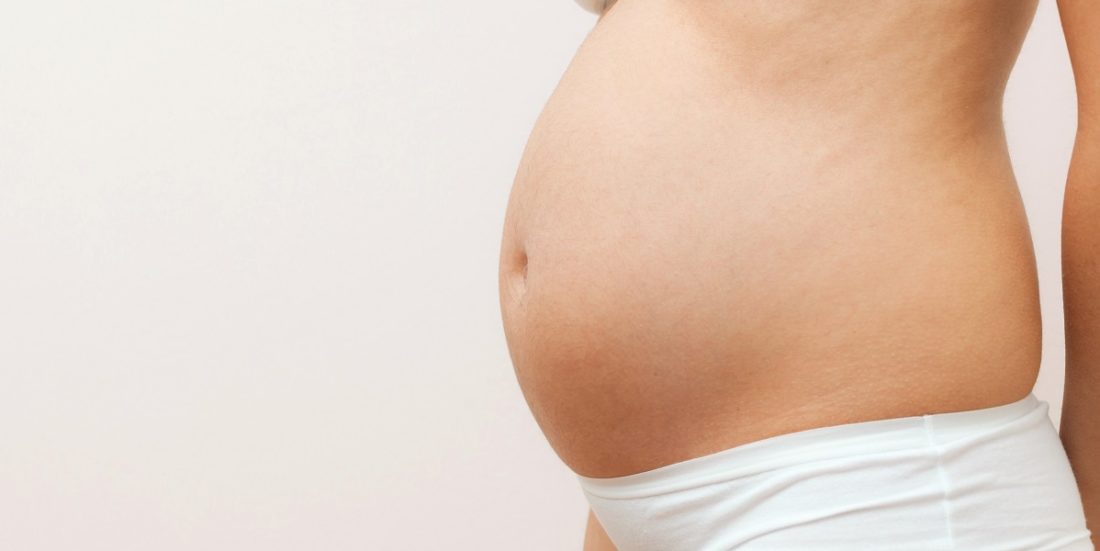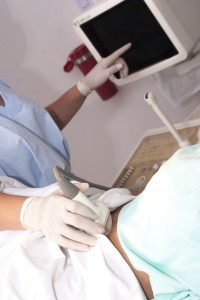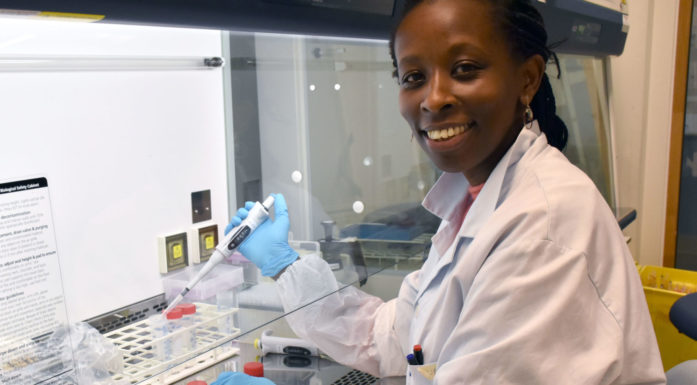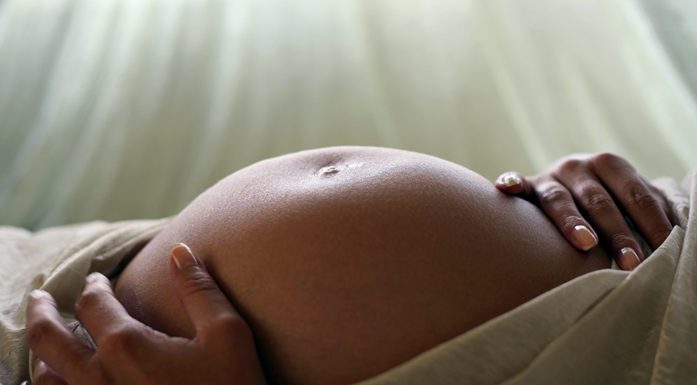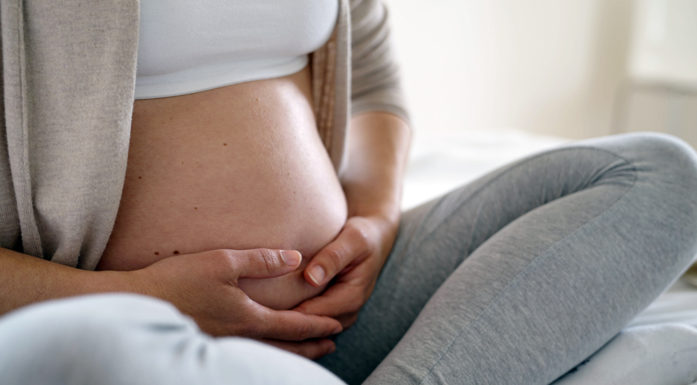Learning more about preeclampsia
Preeclampsia doesn’t usually cause complications, but sometimes things go wrong. That’s why research in this field is so important.
MOTHER AND CHILD: Preeclampsia strikes about 3 per cent of pregnancies in Norway, and 2 to 8 per cent of pregnancies worldwide. In most cases, symptoms are mild, but occasionally things go seriously wrong, so healthcare providers take the condition seriously. The underlying causes of preeclampsia are not well understood, but recent research is shedding some light on the mechanisms of the illness.
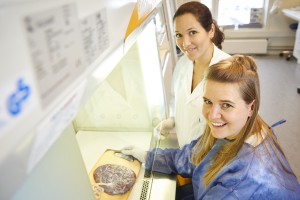
Lobke Gierman (sitting) and Gabriela Brettas Silva in the laboratory with a placenta. Photo: Jacob Storgaard Jensen, Storgaard Design, NTNU
“Preeclampsia doesn’t show up in the mother until the second half of pregnancy, but the cause is found in the first half,” says Professor Ann-Charlotte Iversen at the Centre of Molecular Inflammation Research (CEMIR) and NTNU’s Department of Cancer Research and Molecular Medicine.
And not by chance, several important research results in the field were presented at the CEMIR Conference on Molecular Mechanisms of Inflammation held in Trondheim in early June.
Pregnancy is a natural state of inflammation
“Pregnancy is actually a natural inflammatory condition, and in preeclampsia the inflammation gets too strong and turns into an illness instead,” says Iversen.
Previously, it was widely believed that a mother’s immune system is lowered during pregnancy to prevent the woman’s body from rejecting the unborn baby. But it turns out not to be like this at all.
On the contrary, the immune system is in a higher state of readiness throughout the pregnancy.
- You might also like: Information from 30 000 pregnant women can save lives
Starts in the placenta
Preeclampsia typically shows up as high blood pressure and excessive protein in the urine in a pregnant woman. But the underlying cause is most often found in the placenta and in the interaction between mother and child.
Most preeclampsia research has focused on the third trimester, since the mother’s symptoms first appear late in pregnancy. But the CEMIR researchers have instead taken a closer look at the inflammatory processes in the first half of pregnancy.
“Preeclampsia is limited to the placenta in the early part of pregnancy,” says Iversen. “By mapping the inflammatory signals in the mother’s blood, we’ve shown that the illness isn’t visible there in early pregnancy.”
With her colleagues, Iversen has specifically looked at the role of some foetal cells called trophoblasts. When the fertilized egg is implanted in the uterine wall, trophoblasts grow into the uterine wall and form the link between mother and child. The key to preeclampsia may lie in these foetal cells.
Blood supply
Trophoblasts are specialized cells that ensure an adequate blood supply to the foetus during the formation of the placenta, among other things. Trophoblasts also protect the other foetal cells in the placenta and provide direct contact with the mother’s immune system.
Trophoblasts penetrate the uterine wall and its blood vessels. Close interaction between the trophoblasts and the mother’s immune system is essential, as any activation of these cells can be a source of problems.
In cases of preeclampsia, one can see that trophoblasts haven’t penetrated as far into the uterine wall as they should, which hinders the blood flow to the placenta and foetus. It may be that trophoblasts hold a key to understanding this inflammatory condition.
Role in the immune system
Iversen says that trophoblasts clearly play a role in the immune system.
Researchers at CEMIR have found that trophoblasts have a wide expression of active receptors, or binding sites, that can react to viral and bacterial infections, but also to danger signals from damaged tissues, such as during inflammation. These are called toll-like receptors or TLRs, and the wide expression of TLRs suggest that trophoblasts play a more important role in inflammation than previously thought.
This is totally groundbreaking news. One of the reasons this hasn’t been found previously may be because CEMIR is studying fresh trophoblasts that are isolated from the placenta.
Must use healthy cells
“The placenta is dying when it comes out,” says Iversen.
This means that cells in the placenta need to be examined quickly, within about three days, before they die.
So for practical reasons, much of the research in this field has been carried out on cultured cells, called cell lines, rather than on fresh cells from the placenta, in part because it gives scientists more time to do their research. Cell lines seem to resemble fresh cells because they also express TLRs.
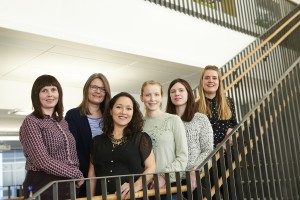
Here are some of the NTNU researchers studying preeclampsia: Bente Skei, Ann-Charlotte Iversen, Gabriela Brettas Silva, Guro Sannerud Stødle, Siv Boon Mundal and Lobke Gierman. Photo: Jacob Storgaard Jensen, Storgaard Design, NTNU
“But,” says Iversen, “trophoblasts that are cultured this way don’t respond when you apply danger signals or bacterial substances to the cells.”
The cell lines do not react when you add inflammatory foreign substances, except partially in one variant which scientists rarely use because the cells are so hard to come by. So in effect, researchers have to use fresh trophoblasts to understand how they contribute to inflammation.
Leading researchers attend conference
From 30 May to 2 June, some 200 researchers who study molecular mechanisms underlying inflammation came to Trondheim for the conference organized by CEMIR. The pregnancy study was part of the research presented at the conference.
“These are some of the world’s foremost researchers in the field,” says Professor Terje Espevik, who is affiliated both with CEMIR and NTNU’s Department of Cancer Research and Molecular Medicine.
CEMIR is a Norwegian Centre of Excellence (abbreviated SFF, after its Norwegian name), and therefore has access to funding from the Research Council of Norway, providing a stable framework for researchers.
Sources: Functional Toll-like receptors in primary first-trimester trophoblasts. Line H. Tangerås, Guro S. Stødle, Guro D. Olsen, Ann-Helen Leknes, Astrid S. Gundersen, Bente Skei, Anne Jorunn Vikdal, Liv Ryan, Bjørg Steinkjer, Merete F. Myklebost, Mette Langaas, Rigmor Austgulen, Ann-Charlotte Iversen.
Toll-like receptor profiling of seven trophoblast cell lines warrants caution for translation to primary trophoblasts. Lobke M. Gierman, Guro S. Stødle, Line H. Tangerås, Marie Austdal, Guro D. Olsen, Turid Follestad, Bente Skei, Kristin Rian, Astrid S. Gundersen, Rigmor Austgulen, Ann-Charlotte Iversen.
Distinct First Trimester Cytokine Profiles for Gestational Hypertension and Preeclampsia. Line H. Tangerås, Marie Austdal, Ragnhild Skråstad, Kjell Å. Salvesen, Rigmor Austgulen, Tone F. Bathen, Ann-Charlotte Iversen.
